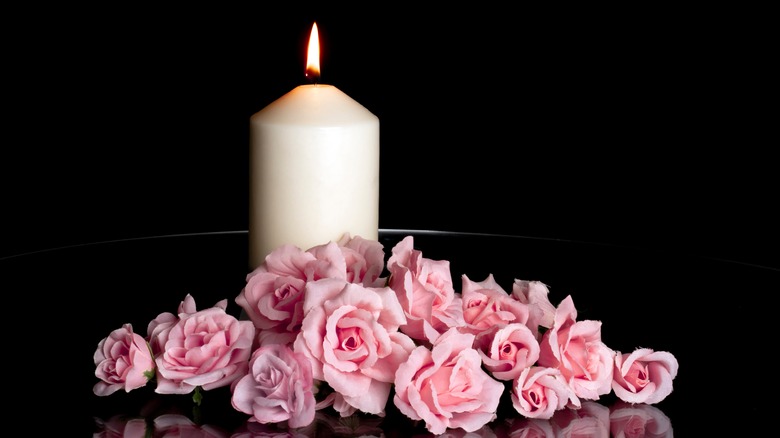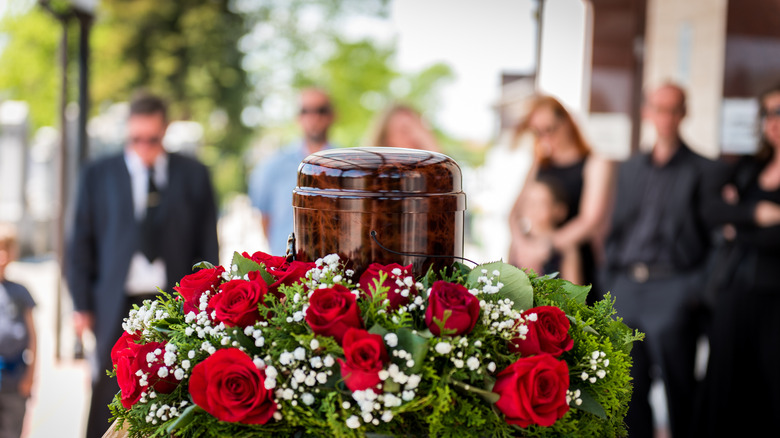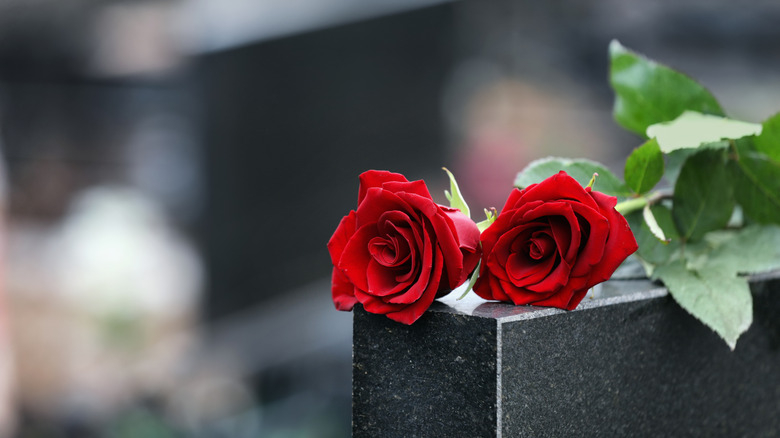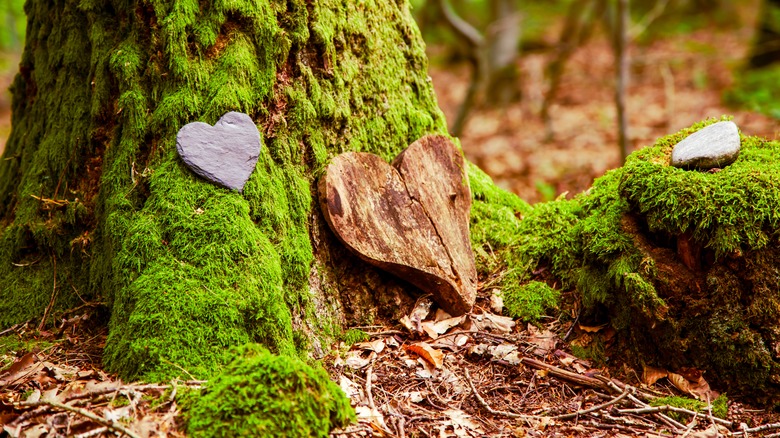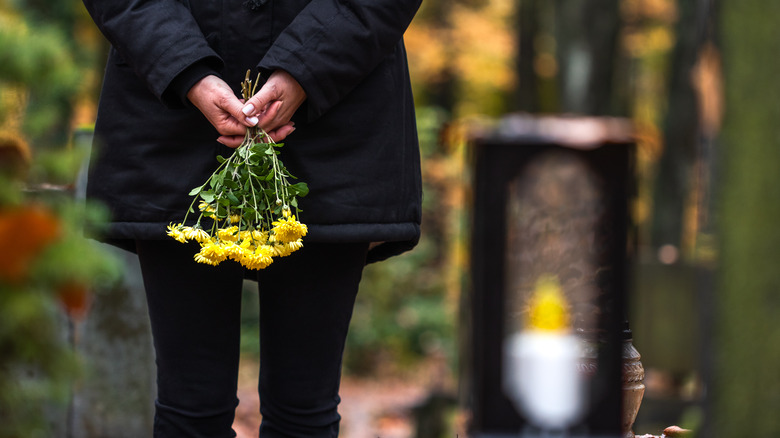The Most Popular Form Of Burial Service Might Surprise You - Exclusive
In the United States, a traditional funeral is arranged by a funeral home — which helps families plan a memorial service and arrange the burial. The deceased is usually embalmed, and the memorial service includes a viewing of the preserved remains. At the conclusion of the funeral service, Funeral Consumers Alliance reports the body is sealed inside a casket, which is then placed into a vault on the grounds of a public cemetery. The grave is then covered with soil and the site is marked with a gravestone.
Although traditional funerals have been the norm for decades, and are often expected, they can be cost-prohibitive. According to Lincoln Heritage Funeral Advantage, the average cost of a traditional funeral and burial is generally between $7,000 and $12,000. In stark contrast, a direct cremation, without funeral services or burial, costs between $2,000 and $5,000.
Speaking exclusively with Grunge, Sarah Chavez, Executive Director of the Order of the Good Death, said, " ... over the past few years there has been an increase in cremation, and today it is now more popular than modern casketed burials. Both the Cremation Association of North America and the National Funeral Directors Association project that by 2040, four out of five Americans will choose cremation over casket burial."
As reported by CNN, the increase in cremation is due to numerous factors, including cost considerations and a decrease in religious restrictions.
The Catholic church used to prohibit cremation
Prior to the 1960s, CNN reports the Catholic church strictly prohibited cremation. However, in recent years, the Vatican has allowed cremations — as long as a Catholic funeral ceremony is performed and the remains are buried in a cemetery (via CNN).
As reported by Choice Mutual Insurance Agency, cremation is currently the most popular option for dealing with a loved one's remains, with a traditional burial being the second most popular choice. However, there is an increased interest in alternative options, including options that are more environmentally friendly and natural.
Some families simply are not aware of all the options available. In some cases, traditions have been mistaken for matters of law. However, the Order of the Good Death executive director Sarah Chavez dispelled some of the more common misconceptions.
It is often assumed that embalming is required by law. However, Chavez said, "Embalming is never required by law. However, keep in mind that funeral homes are privately owned businesses with the legal right to set their own policies and requirements, so a funeral home may require a family to embalm if they want to have a viewing, but again this is a policy, not a legal requirement."
Green burials are becoming a more popular option
It is also commonly believed that laws require remains to be buried in a casket. Chavez explained, "With some exceptions, cemeteries are primarily privately owned and run businesses, and like funeral homes or any other business, they can create their own policies. Green burial grounds, and hybrid cemeteries which are a combination of modern casketed burials with space set aside for green burials, typically allow for bodies to be shrouded and placed directly into the earth."
With the knowledge that funeral and burial laws are not as restrictive as often believed, Chavez said "more eco-friendly choices like alkaline hydrolysis, sometimes referred to as 'water cremation,' green burial, or Natural Organic Reduction aka human composting," are increasing in popularity.
Chavez said certain religions, including Jewish and Muslim faiths, conduct green burial as a matter of tradition. However, "with an increasing number of people becoming aware of the environmental toll of both modern casketed burials, and flame-based cremation, there is increased interest in green burial and other, more sustainable forms of internment."
According to Chavez, "a 2018 survey conducted by the National Funeral Directors Association [found] almost 54 percent of Americans are considering a green burial, and 72 percent of cemeteries were seeing an increase in demand."
Human composting turns remains into usable soil
For families who prefer a more traditional, yet environmentally friendly, option, the Order of the Good Death reports there are several companies that offer biodegradable caskets, shrouds, and urns, which can be buried in traditional cemeteries. There are also specific cemeteries and other burial grounds, which are specifically set up for green burials.
Another option that is growing in popularity is natural organic reduction, which is also called human composting. As reported by Recompose, the body is placed inside a stainless steel container with alfalfa, straw, and wood chips. Over a period of 30 days, naturally occurring beneficial bacteria and microbes in the body and plant materials work together to break the body down into soil. The process is further assisted by manually rotating the container several times throughout the 30 days to provide aeration and promote natural decomposition.
At the end of the 30 days, the container is opened and any non-organic materials, including medical devices and implants, are removed from the soil. Although the process does break down most of the bones and teeth, any remaining fragments larger than one centimeter are placed in a cremator, which is the same machine used by crematoriums to break down any remaining bone fragments after cremation.
After processing, the soil is tested for environmental safety. It is then left to cure and dry for another two to four weeks.
Water cremation is also gaining in popularity
According to Recompose, the entire process takes approximately six to eight weeks and each body produces an estimated one cubic yard of soil. The soil is either returned to the family to use in their garden or donated to conservation organizations. According to Northwest Registered Agent, human composting costs an average of $5,000, which is cheaper than a traditional funeral and burial, but slightly more expensive than cremation.
Alkaline hydrolysis, which is also called water cremation, is another option growing in popularity. In addition to being more environmentally friendly than traditional cremation, it is a better alternative for those who are opposed to the use of fire or are disturbed by the idea of traditional cremation.
As reported by the Cremation Association, the body is sealed in an air and water-tight chamber. The chamber is then filled with nearly 100 gallons of liquid, which is a mixture of alkaline chemicals and water. The specific ratio of the liquids is determined by the deceased person's body mass and sex.
The content of the chamber is heated to between 199 and 302 degrees Fahrenheit and the chamber is agitated and pressurized for up to 16 hours, depending on the deceased's body mass. The remaining bone fragments and other material are dried, then processed through a cremator.
Although bone fragments remain after any cremation process, the Cremation Association reports as much as 32% more material remains intact after a water cremation as opposed to traditional cremation.
Some of the alternative options are prohibited by state laws
Like a traditional cremation, the remains can be buried or returned to the family. As reported by Funeral Circle, water cremation generally costs between $2,000 and $3,300, which is slightly more expensive than traditional cremation, but is far cheaper than a traditional burial.
Although environmentally-friendly options are becoming increasingly popular, and are less expensive than a traditional funeral and burial, they are not widely available. In some areas, the more unconventional processes are not permitted by law. Water cremation, for example, is currently legal in fewer than half of U.S. states.
Some people are also reluctant to choose the less conventional options, as they simply do not understand what is involved in the processes. However, as organizations like the Order of the Good Death continue to raise awareness about the variety of options available, it is expected that environmentally-friendly options will become more accepted and widely available in the future.
